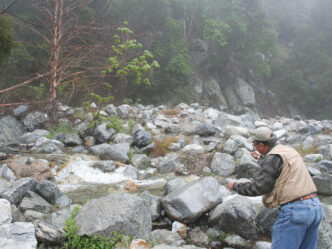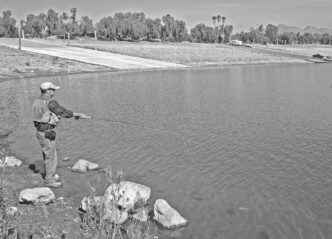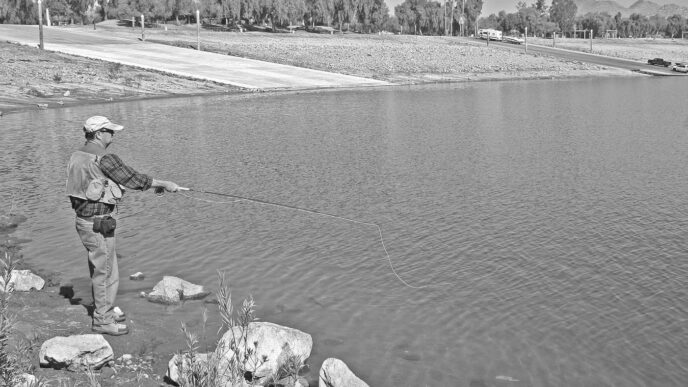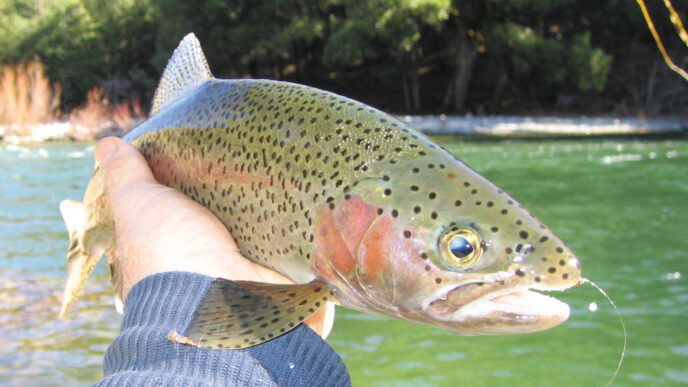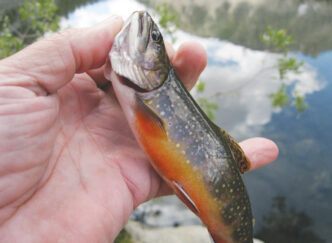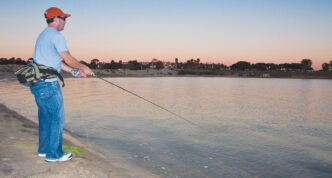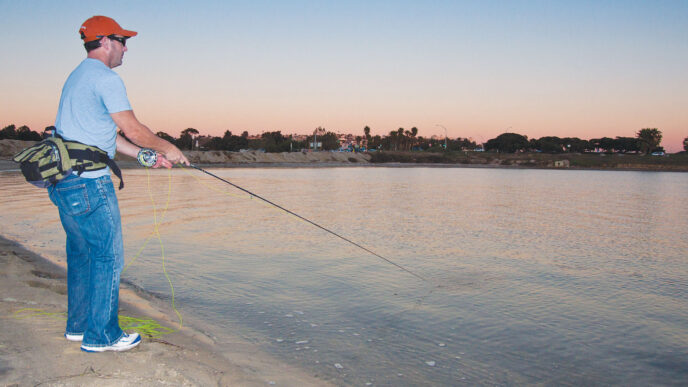The operative phrase these days is “cabin fever.” It is the middle of the winter, and you can hardly stand to be cooped up in the house. You’ve read the fly-fishing books you got for Christmas and tied flies until your eyes began to cross. You’ve watched the fishing shows on TV so many times that you can predict when the angler will set the hook. You need to get out and actually fish, but where?
You could drop by your local put-and-take trout lake, where you stand shoulder to shoulder with guys tossing lures and bait for trout that were trucked in that morning. Somehow, this prospect doesn’t seem like it will relieve the itch you have to fish for wild species in a wilder place.
The preferred option, of course, is to head to the trout streams in the local mountains. Yes, you may have snow to deal with, plus subfreezing temperatures, not to mention the thousands of slap-happy snowboarders and skiers who fill the roads to the ski resorts. Still, in the cycle of boom-and-bust cold fronts that slide down the coast during winter, you can usually find a couple of days of improving weather each week or so. The temperature will rise, and it actually can seem a little like the start of spring — at least until the next front rolls in and dumps rain or snow all over your favorite mountain stream.
Basic Considerations
Although the heights of the mountain ranges around the Los Angeles Basin and the Inland Empire will turn white with snow during winter, most of this snow is situated above the 4,000-foot mark — and there’s a lot of trout water that runs below that magic altitude in Southern California. The air temperature, however will often hover around the mid40s, with water temperatures that match. On most winter days, there’s not much point in getting up early or staying on the water through late afternoon. The best action is likely to be in the middle of the day, when both the air and the water have warmed about as far as they can. Over years of winter fishing on Southern California’s chilly trout streams, I’ve caught more fish in the middle hours of the afternoon than any I’ve found early or late. It’s very civilized angling from a time perspective, but the productive hours are often short. I used to arrive on a stream in morning twilight and stand around for the next couple of hours stamping my feet and drinking coffee to get warm. The streams always seemed lifeless in the chill, and it was not until later in the day, when the sun warmed the streambed and got the insect populations moving about, that the angling really began.
It isn’t just the water temperature that counts, either. On lakes, a drizzly, overcast day often brings big fish out of the depths to seek food in the upper few feet of the water column. Drizzle can also help your angling on small streams, presumably because the dimpling of the water’s surface helps mask an angler’s approach. A couple of years ago on San Antonio Creek, soggy weather created a constant drip of water from the trees that overhang the stream. Imagine my surprise when both my fishing partner and I caught our fair share of chunky little trout — a mix of browns and rainbows. I even managed to surprise one small rainbow with a dry fly near the end of the afternoon.
Flies and Rigs
Fish are sluggish in cold water, and stream flows in winter usually are low and clear, so you have to adjust your tactics a bit to fish for Southern California trout during this season. First, except for the most unusual of bluebird days, dry-fly fishing probably should not be your first choice of methods. Yes, you will find some obstinate mayflies hatching in the middle of a drab winter day — Blue-Winged Olives are prone to this behavior — but by and large, dipping a nymph or wet fly beneath the surface is going to be more productive.
A two-fly rig is a favored method. I like a little more weight on the bottom fly, with a lighter nymph on a dropper a few inches above. My preferred olors are like the weather — drab. Charcoal gray or black, dark brown, or muted olive green seem to be the best bets. The most active insect life in a cold winter stream seems to be caddisflies, and these soft colors mimic them pretty well. Sizes tend to be small, with my weighted tippet fly running about size 16 and the dropper nymph between size 18 and 22.
On most Southern California waters, on the majority of winter days, common pattern like a Gold-Ribbed Hare’s Ear, either the nymph or the wet fly, fished with a Copper John as the bottom fly in a twofly rig, will usually prove attractive to trout. A Blue-Winged Olive nymph works very well for me in most places, and in wet flies, there’s not much that works any better than a Leadwing Coachman.
Of course, you don’t always find low, clear water. A few days of warmer weather after a snowstorm has passed through is apt to bring water levels up with runoff, and the streams can become discolored or even a little muddy. If you choose to fish this kind of water instead of retreating to your den to sulk and tie flies, adjust by substituting larger offerings for the small nymphs, Your flies should incorporate a bit of flash so that they can be more visible to the fish.
With the bottom fly weighted a bit, the sink rate is fairly quick, a plus in the diminished pockets and pools of a winter stream. The nymphs, to be really effective, need to be right down along the bottom rubble. You may find that your standard strike indicator spooks fish in the shallower water of winter streams. Going to a neutral color instead of flashy orange or yellow will help, and much of the time, I prefer to fish without any indicator at all.
You can fish a two-fly rig using a pair of wet flies, instead of nymphs. The only real difference is the presentation. I typically fish the nymphs in a dead drift, casting mostly upstream and across, but with a pair of wets on the leader, I do a sort of Czech nymphing presentation, leading the flies a little bit through the deeper holes and under the edges of overhanging banks and rocks.
Winter Destinations
Where to fish? In my part of the Golden State, the first choice is the West Fork of the San Gabriel River. To get there, take Interstate 210 to Highway 39, north of Azuza. Not only is the West Fork of the San Gabriel a pretty little stream with some wild trout for your angling pleasure, it has several things that recommend it in bad or cold weather. First, it is a tailrace stream, issuing from Cogswell Reservoir. This means that the flow rate is roughly the same year-round, and you won’t encounter the extremely low water conditions you might find on some other local streams.
It also has a gated paved road that follows the streambed for the entire seven miles from Cogswell Dam down to the parking lot where it runs under Highway 39. You can’t drive it, but you can walk in or ride a bicycle, even after a strong rainstorm, and navigating the road isn’t difficult. There are other roads on other streams in the Southland you must avoid whenever there’s been rain. The West Fork isn’t one of them.
In the same area, another stream with a decent paved road flanking it — a road that you can drive — is San Antonio Creek. Take the 210 freeway to Mountain Avenue and head north up Mt. Baldy Road. You’ll cross San Antonio Creek near the Forest Service station at the bottom of the canyon and mostly parallel the creek up to Mt. Baldy Village. While the West Fork is rainbow-trout water, San Antonio Creek hosts a mix of rainbow and brown trout that will give you good fishing most of the year. San Antonio Creek isn’t a tailrace fishery, so you have to take what you get in the way of flows. The same is true with its tributary creeks.
If you venture around to the back side of the San Gabriel Range, think about visiting Big Rock Creek. This stream runs northward out of the mountains into the desert foothills to the north. It has several miles of water that can be accessed mostly on paved roads (not true, however, for its upper reaches). To reach this modestly-sized stream, get on Highway 138 either from Palmdale in the west or Phelan in the east and drive to 165th Street. Turn south toward the mountains on 165th and follow the road to the creek.
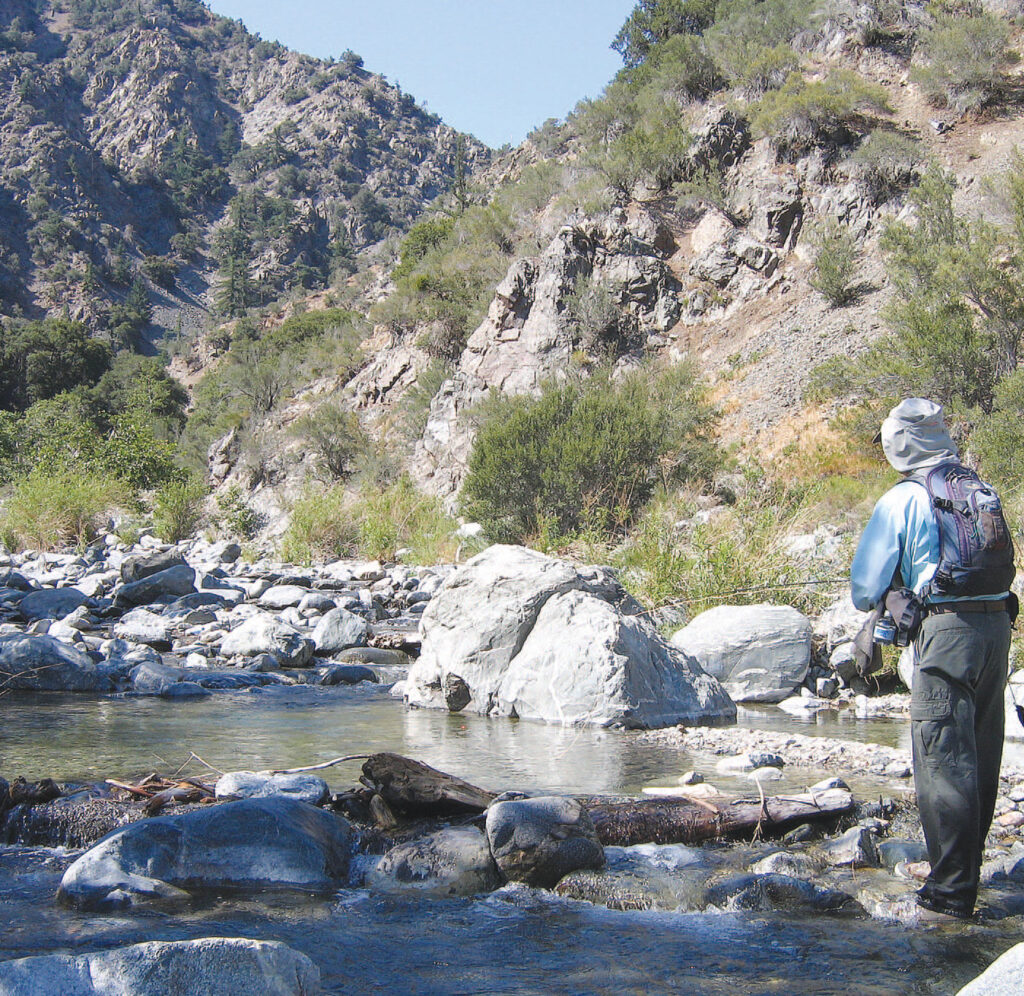
The North and East Forks of the San Gabriel River are also fishable. Take Highway 39 off of the 210 freeway, just as you would to reach the West Fork, but turn across the East Fork bridge to access the East Fork. There you have several miles of walk-in fishing from the trailhead at the end of the road, or simply stay on the main road up to Crystal Lake, and you’ll find the North Fork tumbling alongside the road for a number of miles above where it intersects the West Fork.
The Middle Fork of Lytle Creek is on a dirt fire road, but a lot of the lower stream runs beside the road leading from the Interstate 15 into the community of Lytle Creek. This is a fairly low-altitude water that is often overrun with picnickers and swimmers in the summer, but it lends itself well to winter fishing.
To the east, in the San Bernardino Mountains, you’ll find three streams for decent winter fishing when the most recent serious rain or snow has been over for a few days. Deep Creek is a great summer stream, but suffers from access problems in lousy weather. You have to get up to the altitude of the community of Lake Arrowhead to access the best spots on this stream, and that means being at an altitude of over 5,000 feet. This puts you into serious snow in bad weather, with a resulting downturn in the road conditions.
Better is the Santa Ana River. You do have to climb into the mountains to access this small stream, but much of it runs near pavement, or at least near well-maintained dirt fire roads. Unless it is actually raining or snowing, this area is usually fairly easy to access off Highway 38 on the way to Big Bear Lake in the Barton Flats area. Take Seven Oaks Road (paved) off Highway 38 down into the canyon that holds the stream.
This same area provides access to Bear Creek, but unlike the fire roads along the Santa Ana, those leading into the lower end of Bear Creek are not very good even in the middle of a dry summer, much less in poor or uncertain winter weather. It can be sloppy going, even for rugged four-wheel-drive vehicles.
This winter you needn’t succumb to cabin fever. Get out and snoop around a little, and you’ll find some water where you can fish over wild trout in relative comfort and probably in more solitude than you’ll ever find on a spring day. The fishing will be fair, no more than that, but it’s better than staying home.
Bundle Up
Managing your body temperature is critical for winter fishing. For starters, stay out of the water as much as you possibly can. Even insulated waders will stay out of the water as much as you possibly can. Even insulated waders will get cold eventually, and why push yourself into being cold and miserable if you don’t have to do so? Fortunately, most of the small streams you’ll fish during the winter months in Southern California don’t require much wading to fish well. Lately, I’ve taken to wearing just knee-high farmer’s rubber boots when fishing a lot of these smaller streams. I get into the water only to cross the stream or retrieve a fly hooked on a rock or stick — no serious wading for this old boy.
I’m not going to get into the many forms of warm clothing you can find in catalogs or on the Internet. (See Ralph Cutter’s “Under the Alders” column in this issue for thoughts on that.) There are many manufacturers producing undergarments and outerwear for your needs. Some of it is inexpensive, and most isn’t. You can be as toasty as can be in subzero weather, but why bother? The trout won’t be biting. If you aren’t comfortable in moderate winter clothing, the chances are good that the fishing will be poor.
You need to balance the amount of warm clothing you wear for the hike in to some waters with the level of activity afterward. You don’t want to work up a sweat walking to the stream, then slow down and get cold when you actually are fishing. If it is threatening to rain or snow or if the wind is blowing, a rain jacket over a fleece or wool sweater vest, jacket, or sweatshirt is a good idea. The rain jacket, in addition to keeping you dry, will block a lot of cold air and allow your body heat to be conserved inside the fleece liner or shirt. You may want to carry that fleece or wool undergarment or jacket while you hike and don it streamside to prevent chilling later on. I like to wear a wool watch cap while fishing in the winter. It helps keep my ears warm. For gloves, I like the ones with the open fingers on the first and second fingers and the thumb to allow me to manipulate the line and leader.
You can carry this staying warm business a long way. There is an an impressive array of space-age materials now in use to create many types of warm winter clothing. Always keep in mind, though, the contraints that angling create. I once fished a whole day in a custom snowmobile suit, and while I was always comfortably warm, the suit restricted my casting to the point where it wasn’t much fun after a couple of hours.
Richard Alden Bean



